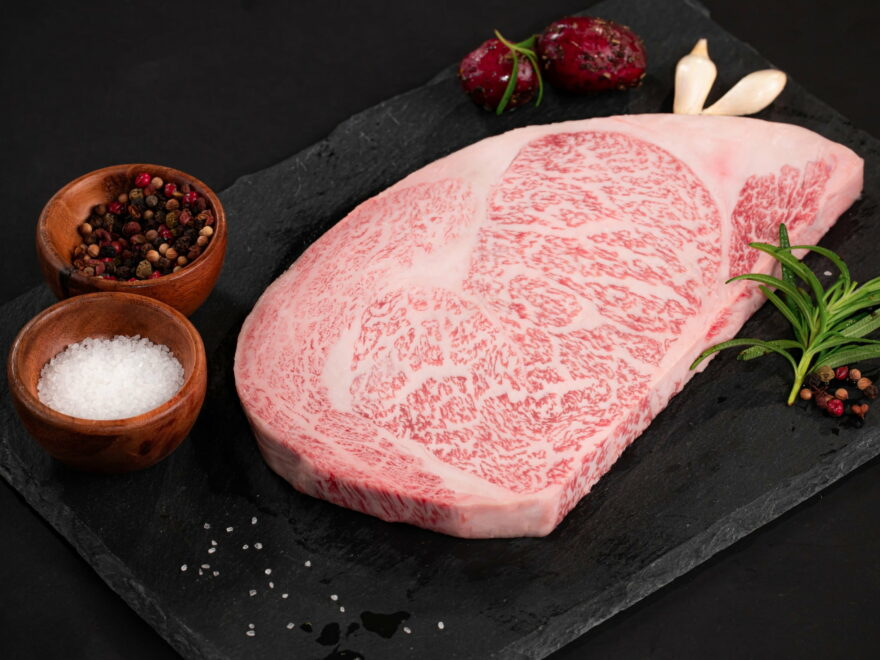It doesn’t take a background in craft butchery to know that the terms Kobe and Wagyu are synonymous with “high-quality” and “ooh-aah!” Any encounter with either of these beef products is bound to affect everything you think you know about meat, forever changing your idea of what a great steak is. But there is still a lot of confusion surrounding these two terms and what they each actually mean.
Wagyu and Kobe are of course closely related to one another, but there are some important distinctions that set them apart–justifying that high price tag that Kobe sports. Hungry for more? Good news, because we’re serving up a big portion of everything you need to know about two of the highest quality beef products you can get your mitts on: Kobe and Wagyu.
What is Wagyu Beef?
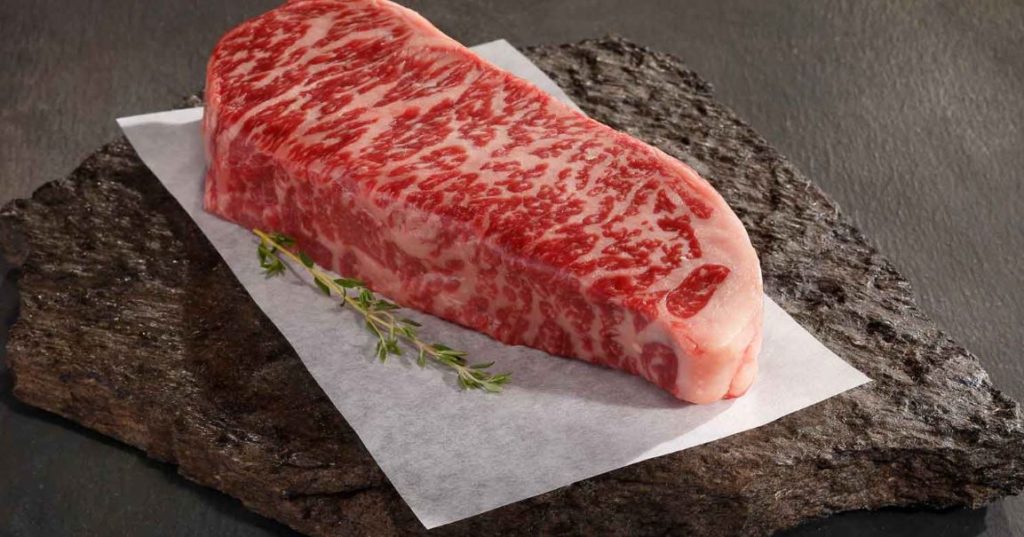
Roughly translated, the word Wagyu actually means “Japanese cattle”. Nice and simple, right? If only! The complication lies in the fact that there are a number of different Japanese beef cattle breeds which produce Wagyu meat, and of course, they’re not all the same.
The thing that all Japanese Wagyu breeds have in common is their genetic makeup, which makes them more likely to develop a greater proportion of fat within their muscle tissue.
Wagyu cattle can actually be any of the following four breeds:
- Kuroge (Japanese Black Cattle): this Japanese cow breed is considered to be the king of marbling! Boasting the highest proportion of intramuscular fat, this is the breed from which the majority of Wagyu beef comes.
- Akage (Japanese Brown Cattle): these cattle tend to be leaner than the black cattle, with a more mild taste.
- Mukaku (Japanese Polled Cattle): produces meat that is less buttery and more chewy than the other breeds, with a somewhat gamier flavor due to a higher proportion of amino acids.
- Nihon Tankaku (Japanese Shorthorn Cattle): the meat from this breed is notably high in glutamic acid, giving it an extremely savory flavor!
It’s important to note that while the term Wagyu does essentially translate to “Japanese cattle”, not all Japanese cattle can be sold as Wagyu. Cuts of meat from cattle which do not come from Wagyu specific breeding or bloodline are sold under a different designation.
What is Kobe Beef?
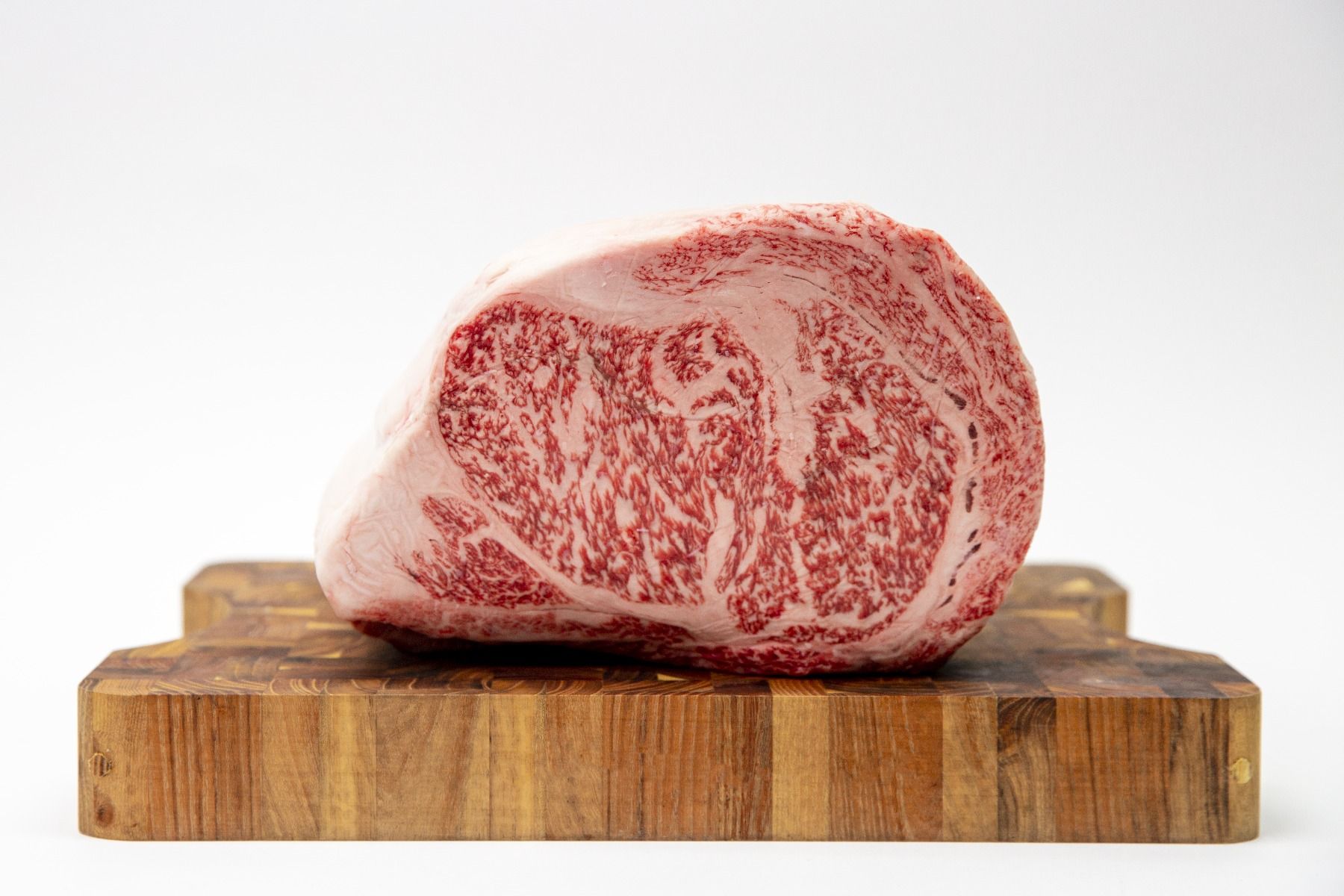
To further complicate things, Kobe beef is yet another category of Japanese beef. Just in the same way that not all Japanese beef is considered Wagyu, not all Wagyu beef is considered Kobe. Rather, Kobe is just one very specific variety of Wagyu.
Authentic Kobe beef only comes from one breed of cattle, the Tajima-Gyu cattle, which is a strain of the Japanese Black cattle. Not only that but in order for their meat to qualify as Kobe beef, the cows must be raised in Japan’s Hyogo prefecture, a region of west-central Japan. The capital of this prefecture is the city of Kobe, hence the name of their world-famous beef!
Certified Kobe beef must be raised according to certain standards and meet several strict grading requirements upon slaughter. Products such as Champagne and Balsamic vinegar have similar regulatory systems as well. While it’s true that anyone could produce sparkling wine from the same species of grape or age their vinegar according to the same process, marketing these products under the protected designation is strictly forbidden, and such is the same with Kobe beef as well.
These regulations work to ensure that the quality and consistency of any meat that bears the Kobe name will meet the expectations of consumers–consumers who are paying top dollar and expecting to receive a worthy product. Here are the main criteria that must be met in order for Wagyu to be deemed worthy of the Kobe designation:
- Kobe beef must come from cattle of pure Tajima-Gyu bloodline.
- The animal must be either a steer (castrated male) or virgin cow (female).
- The cattle must be born and farm raised within the Hyogo Prefecture.
- The processing of the meat may only be done at an accredited slaughterhouse within the Hyogo Prefecture as well.
- Certified Kobe beef must have a marbling rating (BMS) of 6 or higher.
- The Yield Score must be either A or B.
- The Meat Quality Score must be a 4 or above.
- The gross weight of the edible meat from any one steer or cow may not exceed 470 kilograms.
- All authentic Kobe is to be assigned a 10 digit identification number.
How is Kobe Meat Graded?
As mentioned above, there are three key rating systems that all Kobe beef is scored on.
The Beef Marbling Standard (BMS)
This marbling rating is intended to measure the fat marbling to meat ratio and is scored on a scale of 1 through 12. In order to qualify as Kobe beef, meat must earn at least a No. 6 ranking on this scale.
The Yield Score
The Yield Score indicates the proportion of edible meat found on any on given animal. This score is more limited with only 3 options: A, B, or C. Kobe beef must earn either an A or B rating here
Meat Quality Grading
The Meat Quality grade is calculated on a scale from 1 though 5 that takes several specific factors into account such as fat marbling, meat color, fat color, and overall texture. Kobe beef is required to score at least a 4 on this scale.
What Makes Kobe and Wagyu Meat Special?
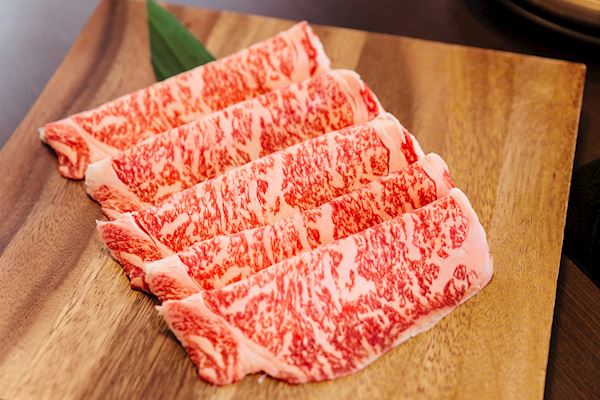
By now you know everything there is to know about the different breeds of Wagyu beef, and you finally understand the exact meaning of the term Kobe, but how does all of this set Wagyu and Kobe apart from one another in the ways that matter most to you, the consumer? There are 3 main areas to consider!
Livestock Farming Techniques
It would be safe to say that Wagyu cattle are raised extremely well. Make no mistake, these are still livestock animals, but the farmers who raise Wagyu–and especially Kobe–cattle take excellent care of their animals. The lives the cattle live have a great impact on the resultant quality of their meat upon slaughter, and so for Wagyu breeders, it quite literally pays to keep the animals in stress-free and comfortable environments.
In addition to pasture access when possible, Kobe cows are given supplementary feed which contains grasses and grains that are native to the Hyogo Prefecture such as rice, straw, corn, soy, and wheat bran. You may have heard the lore that Wagyu farmers also feed their cows beer or sake. While it doesn’t seem that this is a regular practice, there is no guideline against this practice and some breeders may opt to booze-ify their cattle feed from time to time as a means to boost their appetite.
Quality, Texture, and Flavor of the Meat
Wagyu meat, no matter which breed it hails from, is notably more marbled than the meat from other types of cattle. This imparts an unctuous texture and savory flavor to the meat, however, different cuts of Wagyu meat can vary widely from one to the next. Wagyu may be rich and creamy like Kobe meat, or it may be more gamey and chewy.
Where Wagyu offers extremely high quality meat products, the caliber of authentic Kobe meat is unparalleled. The specific bloodline of Kobe cattle, as well as the careful rearing of the animals themselves, makes for the most marbled beef of any of the Wagyu varieties. The fat content of this meat results in an especially rich flavor and buttery texture, with such a melt-in-your-mouth consistency that some folks choose to eat thinly sliced Kobe beef raw! Also, due to the stringent regulations, Kobe will offer an overall more consistent flavor experience as opposed to Wagyu.
Price and Availability
In terms of availability, Wagyu takes the cake. Not only is it far more widely available across its home country of Japan, but Wagyu is also readily produced in other regions of the world as well, which we’ll discuss a bit more in a moment.
The fact that certified Kobe is restricted to being produced by Tajima cattle that are raised in the Hyogo Prefecture, and must meet so many other governing criteria, severely limits its availability. This makes Kobe beef far more expensive than Wagyu, which already fetches a higher price as compared to most traditional American-raised cattle.
Other Types of Wagyu Beef
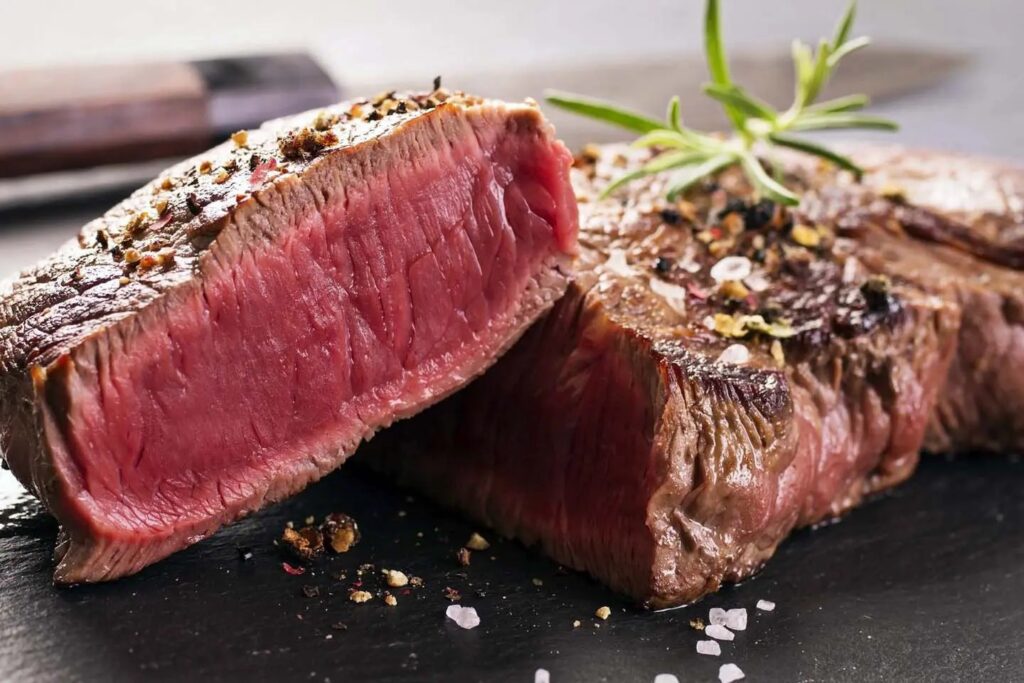
It’s a fact that there can only be one Kobe, however, when it comes to Wagyu, there is a bit more flexibility. The term Wagyu–meaning “Japanese cattle”–does not necessarily indicate the livestock is actually born and raised in Japan, and may actually refer to crossbred Wagyu that is raised in other countries.
The meat from these types of Wagyu cattle is certainly different as compared to Japanese raised beef and it’s worth noting that the meat from these breeders is not recognized as authentic by the same governing body that manages Japanese Wagyu beef. Nevertheless, the following types of Wagyu beef are wonderful products that are far more readily available to most folks.
American Wagyu Beef
Most American Wagyu is a cross between Japanese Wagyu and Aberdeen Angus breeds of cattle, which has resulted in a wonderfully flavorful and unique variety of high quality meat. Any American Wagyu meat must come from cattle which are of at least 49.875% pure Wagyu heritage, and the American Wagyu Association sets forth several other criteria for verifying the genetic legitimacy of any American Wagyu cattle.
American raised Wagyu is certainly leaner than genuine Wagyu from Japan, however it still boasts plenty of fat marbling which sets it worlds apart from pure Angus beef or other more typical varieties.
Australian Wagyu Beef
Australian Wagyu beef is some of the best Wagyu you’ll find outside of Japan. Not only are the livestock raising conditions more optimized for producing superior quality meat, but the Wagyu bloodline in Australia is more pure than that of the United States. There is a greater proportion of 100% pure Wagyu cattle in Australia, making for stronger genetics across the herd which results in cuts of beef that are more in line with the authentic counterparts in Japan.
Kobe or Wagyu, Which is Healthier?
Whether you opt for Wagyu or Kobe (if you can even get your hands on some!), you’re in for some major health benefits. Not only are these types of meat high in protein and packed with all nine essential amino acids, but they are also incredibly high in fat.
Yes, we are considering that a health benefit because the fats found in Kobe and Wagyu are not just any old fat, rather they are extremely healthful forms of monounsaturated fat and several vital omega fatty acids. This means that Wagyu is one red meat option that is surprisingly low in cholesterol! If this sounds like just what the doctor ordered, be sure to check out our full guide to low-cholesterol cuts of beef.
In terms of how Wagyu vs. Kobe compare to one another nutritionally, it’s arguable that as Kobe tends to have the most marbling of all the Wagyu varieties, it is likely to be higher in healthy fats. Other cuts of Wagyu, on the other hand, may be higher in the protein department, especially those crossbred American and Australian varieties.
Kobe Beef vs. Wagyu Beef FAQs
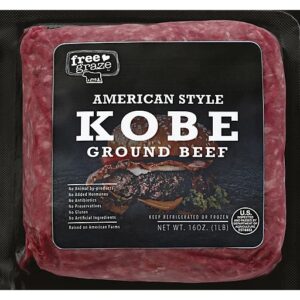
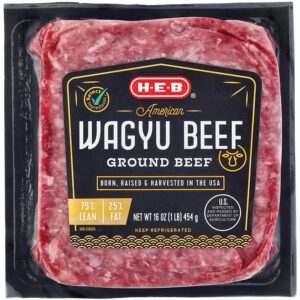
How Can You Tell You’re Getting Real Kobe Beef?
Since Kobe is considered the top of the line, and is served with top of the line prices that match, how do you know when you’re looking at a veritable Kobe steak and not a lesser (albeit still entirely delicious) cut of Wagyu? There are a few things you can keep an eye out for.
Read Carefully
Simply put, there is no such thing as American Kobe beef. However, you may see packages of meat or restaurant menu items designated as Kobe-style, which is an extremely important distinction and not at all the marker of genuine Kobe beef.
Imported beef straight from Japan is your only option when sourcing real Kobe, anything else is tricky marketing techniques.
Check the Price Tag
It should be astronomically high, and here’s why. In order to have true Kobe beef in your hands, the cattle it hails from would have to have been born, raised, and slaughtered in Japan, verified to meet all criteria, and then rapidly shipped.
Not only is this an extremely expensive process, but it is also rarely done as Japan regulates the amount of Kobe meat they export. Bottom line: Kobe meat in Japan is expensive, and outside of the country the price rises exponentially. If the price tag seems too good to be true, it is.
Do Your Research
Whether you are sourcing Kobe from a butcher shop or ordering it at a restaurant, do a little background check on the purveyor before ordering. Japan exports Kobe to select businesses around the world and you can see a comprehensive list organized by region here.
In addition to researching the restaurant or retailer, you should obtain and research the 10-digit certification code of any Kobe beef you intend to purchase. You can use this website to get specific information about the Kobe beef in question and to confirm its pedigree and point of origin.
Are Kobe Burgers Made From Real Kobe Beef?
Sorry to say, but those extra pricey burgers you see at the local steakhouse are not made from real Kobe. When a cut of meat is so highly prized as Kobe, turning it into ground beef would be a massive waste, resulting in huge financial loss all around. Seeing as Kobe is just about the highest quality beef you can get, grinding it up into a burger would be an extremely poor way to use it.
Now that’s not to say that “Kobe burgers” are nothing special! Most are made from the meat of domestic Wagyu, giving the ground beef that awesome mix of marbling and beef flavor. Don’t be dissuaded from giving Kobe-style ground beef a shot but be aware it is indeed, Kobe-style, not authentic Kobe.
Are Japanese Cattle Really Massaged Every Day?
Interestingly enough, this is a burning question on so many people’s minds! It might sound almost laughable that livestock animals be given this type of treatment which, in a human’s world, is typically reserved for a special occasion or a desperate attempt for some much needed relaxation.
This piece of lore goes back thousands of years to when Wagyu cattle were working animals, helping farmers with any number of agricultural operations. In order to increase the animals’ productivity and workload tolerance, it is believed that cattle ranchers massaged their cows to keep their muscles in good standing.
Whether or not this tradition is continued with the Wagyu and Kobe cattle of today is debated, but surely there is a farmer out there somewhere who is happy to give their prized heifers a stress-relieving rub down from time to time.
Final Thoughts on the Differences Between Kobe and Wagyu
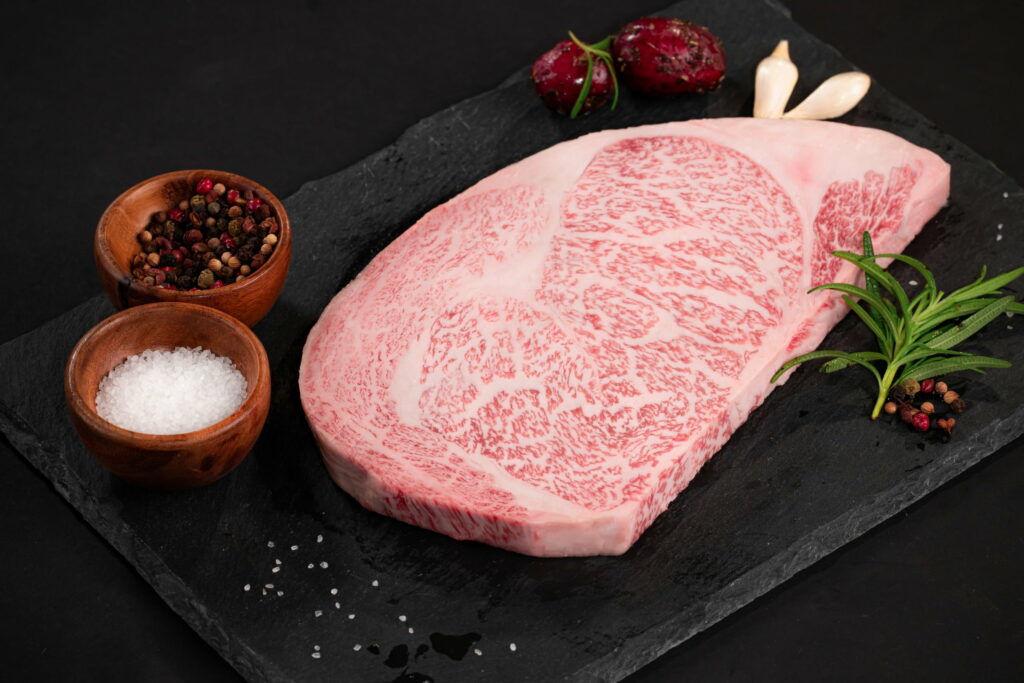
We’ve covered a lot of pasture here, so let’s recap the main points and distinctions between Kobe beef and Wagyu beef!
The main thing to remember is that while there are several breeds of Japanese cattle that qualify as Wagyu, there is only one that can qualify as Kobe beef. On top of this limitation, these cattle must be raised and processed according to incredibly specific standards in order to make the cut and earn a Kobe designation.
Unlike Kobe beef, Wagyu beef is available in regions of the world outside of Japan. Though the Wagyu herds being raised in places like Australia and the United States consist largely of crossbred cattle, these newer takes on Wagyu boast supreme quality and taste as well.
Hungry for more about unique meats and far-from-ordinary protein options? Check out these five exotic meat choices, each of which features a low fat and high protein content! After all of this rich fat marbling, a bit of leanness might be in order!
